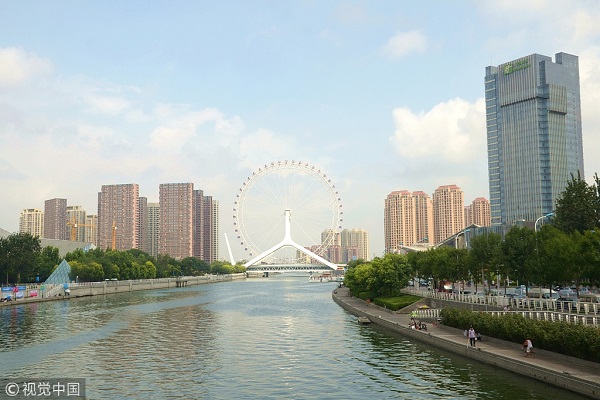Bohai Economic Rim
govt.chinadaily.com.cn Updated: Oct 18, 2018

Brief introduction:
In a narrow sense, the Bohai Economic Rim refers to China’s Liaodong Peninsula, Shandong Peninsula, and the Beijing-Tianjin-Hebei region. Its extension can radiate through 12 percent of China’s land area and 20 percent of its population, covering Shanxi, Liaoning, Shandong, leagues and cities in central and eastern Inner Mongolia.
Beijing, Tianjin, Shenyang, Dalian, Taiyuan, Ji’nan, Qingdao and Shijiazhuang are also included in the economic rim.
Situated at the intersection of Northeast China, North China and Northwest China, the rim connects North China with the Northeast Asia and the Pacific Ocean.
It is also located in the core area of the Northeast Asia Economic Rim and the engine of economic development in northern China and has been hailed as the third growth pole of the Chinese economy by economists, following the Pearl River Delta and the Yangtze River Delta.
Heavily influenced by the traditional planned economy system, the proportion of State-owned economy in Bohai Economic Rim is high. And the governments in the region have a good command on resources and deep influence on enterprises. In 2001, State-owned and State-controlled enterprises above designated size in Beijing accounted for 65.1 percent of its total, 20.7 percentage points higher than the national average.
As the Chinese economy saw a rapid growth over the last 20 years, the Bohai Economic Rim grew into the third largest regional manufacturing center following the Pearl River Delta and the Yangtze River Delta.
The Bohai Economic Rim is home to resource-intensive industries like steel, crude oil and salt and emerging high-tech industries such as electronic information, bio-pharmaceuticals and new materials.
Strategic Development Plan:
The State Council officially replied to the Bohai Rim region cooperation development plan on Sept 15, 2015.
The State Council urged the governments of Beijing and Tianjin municipalities, Hebei, Shanxi, Liaoning and Shandong provinces, and the Inner Mongolia autonomous region to adapt to the economic new normal and improve the quality and efficiency of economic development.
The State Council also directed them to promote coordinated regional development.
The plan aims to turn the region into a new driver of the country’s economic development and industrial transformation and upgrading. It’s hoped that it will be a demonstration area for innovative coordinated regional development and an all-around open and cooperative gateway to the Asia-Pacific region.
The governments were also asked to clarify the division of responsibilities and tasks and map out concrete measures to put the plan into practice.
According to the State Council, speeding up the Bohai Rim region cooperation development is an important step in boosting the Belt and Road Initiative and Beijing-Tianjin-Hebei coordinated development.
Investment Advantages:
Mineral resources
The Bohai Economic Rim is abundant in mineral resources and provides many minerals to the country.
Liaoning is rich in those resources and ranks first in terms of iron ore reserves in China. The iron ore reserves in Anshan and Benxi amount to10 billion tons. It is by far one of the largest proven reserves in the country.
There are various minerals in Shandong province. The iron ore reserves are mainly distributed in Laiwu, Jinan--Licheng and the north of Jinling.
Hebei province has 53 kinds of ferrous metals, non-ferrous metals, metallurgical auxiliary materials, chemical raw materials, building materials and other non-metallic materials, rare metals and precious metals. Its rich iron ore reserves are distributed near the important production bases of coking coal and auxiliary materials, which is conducive to the development of the iron and steel industry.
Energy reserves
It is home to four oilfields -- Huabei, Shengli, Dagang and Zhongyuan -- whose output is second in China only to the Daqing Oilfield. The Bohai Sea is a Mesozoic-Cenozoic subsidence basin with abundant oil and gas resources. The proven oil reserves in the Bohai Bay are over 600 million tons. The Bohai Bay enjoys advantages in meteorological conditions as well as developed economic activity and technology in its coastal areas, which support offshore oil exploitation. A total of six offshore oilfields have been put into operation.
The Bohai Rim has the most abundant coal in China. Its proven reserves of coal account for more than 60 percent of the total coal reserves in China. Among the provincial-level regions in Bohai Rim, Shanxi has the largest coal reserves with proven reserves accounting for one third of all of China’s.
Ocean resources
The Bohai Sea is the largest inland sea in China. Known as a "natural fish pond," it is rich in a variety of fish, shrimp, shellfish aquatic products, and other ocean resources. It is home to about 170 species of marine animals and plants, including more than 100 species of common fish. There are many good gulfs and river entrances in the Bohai sea, which are ideal natural fisheries.
The coast of the Bohai Sea is an important production base of salt in China. There are 47,900 hectares of salt fields along its coast. By the end of this century, they will measure 120,000 hectares.
In addition to the above resources, there are also abundant minerals like petroleum, natural gas, coal, iron, copper, sulphur and gold. Its energy resources include tidal energy, wave energy, thermoelectric energy, wind energy and tidal current energy. Ocean energy is a renewable energy with broad prospects for development and utilization.
Agricultural resources
The Bohai Rim region covers the North China Plain, Huanghuaihai Plain and Liaohe Plain and is one of the most developed agricultural areas in China. It is a major production base for wheat, grains, cotton, oil and fruit. Its western area and the Inner Mongolia grassland are bases for forestry and animal husbandry respectively.
It is a major grain producing area in China. The main grain crops are wheat and coarse cereals. Corn, millet, sorghum and potatoes are important crops in the region.
Cotton is the region’s most important cash crop. The planting area accounts for about half of its cash crop planting area and about one fifth of the cotton producing area in China.
The Bohai Rim region is one of the important edible oil crops producing areas in China. Peanuts are the most important of the major oil crops, which include flax, sesame and rape.
It is also an important dry and fresh fruit producing area in China’s temperate zone. The apples grown in Yantai and the Liaodong Peninsula, Shenzhou peaches, Jiaohe pears, and Leling Jinsi jujube are famous specialties.
Tourism resources
There are various tourism resources, ranging from natural and cultural landscapes to stunning seascapes.
The coastal cities in the Bohai Rim economic region utilize their seascapes to develop modern commercial tourism. Tianjin receives overseas cruise ships regularly. Beijing is home to Liulichang Culture Street, the Dashilan commercial area, the Drum Tower business district, Wangfujing Street and temple fairs. Dalian in Liaoning province holds annual costume festivals, pagoda festivals and marathon races to boost the local economy. Baoding in Hebei province develops health-oriented tourism products, such as tours in the “capital of Chinese medicine”, medicinal diets, qigong training (Chinese breathing exercise) and massage, which are popular among tourists from home and abroad.
![]()





